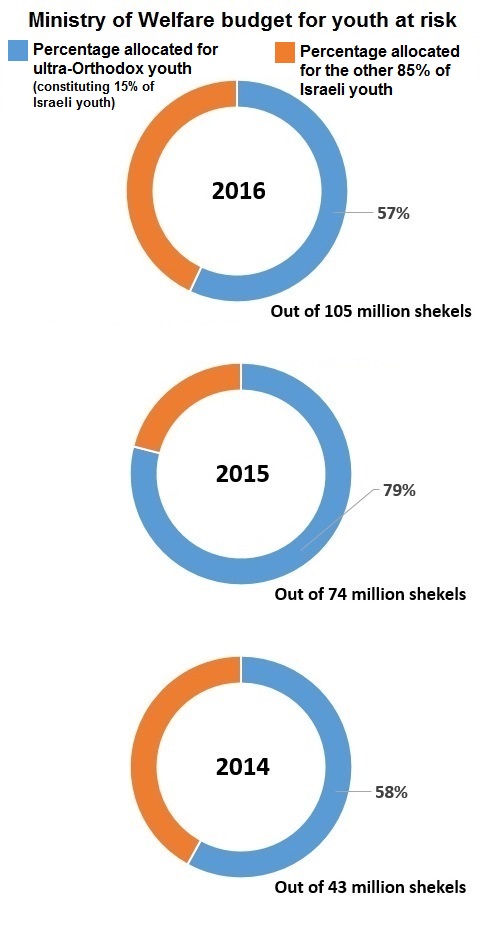For years Haredim receive extra funding for forging Israel's coalition governments
Israeli Funds for Youth at Risk Skewed Toward ultra-Orthodox Jews
Some 60 percent of the funds budgeted for youth at risk goes toward helping ultra-Orthodox teenagers, even though they are only 15 percent of the teen population, according to Social Affairs Ministry data compiled by Hiddush.
09/06/2016 14:10
Tags: Haredim · budget · Hiddush · coalition agreements · coalition · politics · UTJ · Shas
By Lee Yaron, originally posted HERE on Haaretz.
For 2016, the budget for Israel’s service aiding 40,000 teenagers at risk is 105.5 million shekels ($27.6 million), of which some 60 million shekels goes to Haredi youth.
Of the money allocated to the Haredim, around 23 million shekels goes toward helping around 400 teens in boarding schools, 27 million toward treating and rehabilitating teens at risk in the community, and 10 million toward Haredi girls.
“The Haredi parties take care of their constituency and make sure that a significant part of the budget goes to the Haredi community,” a welfare official familiar with the data told Haaretz. “The ministry doesn’t transfer money on its own initiative to Haredim; for years the Haredim have been receiving additions for their youth through coalition agreements.”
Indeed, the March 2015 coalition agreement between Shas and Likud calls for an extra 10 million shekels for Haredi dropouts funded by either the Social Affairs Ministry or the Education Ministry.

In 2015 the entire budget for the service for adolescents came to 74.3 million shekels, of which 58.8 million shekels, 74 percent, went to Haredi youth.
In 2014, when the budget was 43.5 million shekels, Haredi youth got 25.5 million. The Social Affairs Ministry says that after additional budget increments, the entire 2016 budget for youth at risk is 170 million shekels – but even that is more than double the Haredim’s percentage of the population.
Meanwhile, projects aimed at other segments of the population face hurdles. For example, the Women’s Courtyard project for young women at risk may have to close for lack of consistent ministry assistance. The project, which has helped more than 1,000 girls and young women 13 to 25 over the past three years, needs 350,000 shekels to continue.
The nonprofit group running the program says the project had received ministry money to run as a pilot program, but the pilot funding ended in October and now its centers in Haifa, Netanya and Kiryat Malakhi may have to shut down.
These statistics seem to point to blatant discrimination, and it isn’t clear how these scandalous budget items in the Social Affairs Ministry budget even got approved.
“These statistics seem to point to blatant discrimination, and it isn’t clear how these scandalous budget items in the Social Affairs Ministry budget even got approved,” said Hiddush director Uri Regev, adding that the addressing of Haredi dropout rates, though a serious problem, should be done lawfully and equitably under the general budgets for youth at risk.
Groups like Hiddush want the ultra-Orthodox to embrace Israel’s core curriculum that focuses on subjects like math, science and English.
“These high budgets and the high dropout statistics in Haredi education obligate us to ask whether Haredi education itself doesn’t constitute a risk factor for its students. One can’t help but ask whether this isn’t just another example of the Haredi parties milking the public budget,” Regev said.
“But there is grave concern that both answers are right. The main cause of the problem is that Haredi youths are offered only one educational track – yeshivas without core studies for boys and strict seminaries for girls.”
For its part, the Social Affairs Ministry said it invests significant funds for youth at risk among all strata of the population, and admitted that some of the budget for disaffected Haredi youth comes from coalition agreements.
“But in general, the policy of the Social Affairs Ministry is to help all youths at risk,” it said. “The budget for this purpose is divided in accordance with the needs in the field.”